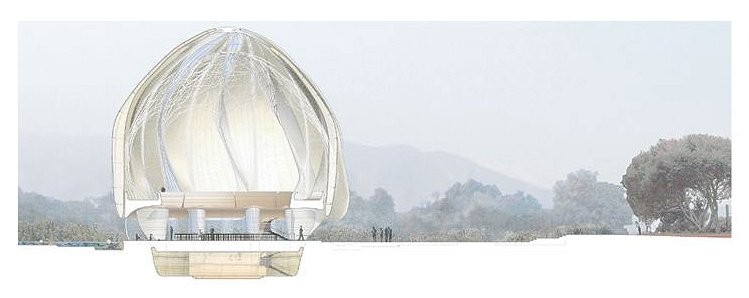
Architects
Architect in Charge
Siamak Hariri - Hariri Pontarini ArchitectsLocal Architect
BL ArquitectosClient
National Spiritual Assembly of the Bahá'ís of Chile, National Spiritual Assembly of the Bahá'ís of CanadaGeneral Contractor
Desarrollo y Construcción del Templo Bahá'í para Sudamérica Ltda.Area
1200.0 sqmProject Year
2016Photographs
Courtesy of Bahá’í Temple of South America
Nearly four years after the start of its construction, South America’s first Bahá’í temple is beginning to take shape. Designed by Canadian firm Hariri Pontarini Architects, the temple is being constructed at the foothills of the Andes in Santiago, Chile. The building is comprised of “nine translucent wings, rising directly from the ground, and giving the impression of floating over a large reflecting water pool,” describes the project’s website. Each wing is designed like a leaf, with a steel “main stem” and “secondary veins of steel” supporting its cast glass exterior. During the day, the cast glass will filter sunlight into the temple, while at night the temple’s interior lighting will produce a soft glow on the outside.
The structure’s steel columns are now fully self-supported on its concrete foundation, and the steel frames and interior marble panels of each of the nine wings have been completed. In October, the project reached an important milestone as the installation of the cast glass cladding began on the outside of the wings.

The 1,200 square meter temple will have two prayer and meditation areas: a central area under the dome with seating for 600 people, and nine alcoves built into a wooden mezzanine circling the building’s interior. Six hectares of gardens will also surround the temple.

Due to Chile’s seismic activity, the building is built over elastomeric seismic isolators and is designed to absorb ground movements.


The temple uses traditional craftsmanship materials, complementing the cast glass and steel with stone flooring and the wooden mezzanine.

Currently there are seven Bahá’í temples located around the world, including Fariborz Sahba’s Lotus Temple in New Delhi, India.
















































